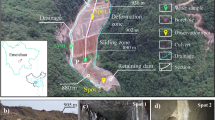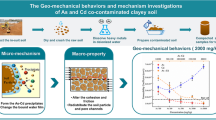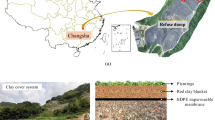Abstract
The potential impact of heavy metal ion infiltration on macroscopic and microscopic soil properties is a subject of academic interest. Laterite has an extensive distribution in southern China and is extensively utilized as a vertical containment wall for landfills. Consequently, there is a need to investigate how heavy metal ions affect laterite’s microstructure and mechanical properties. To examine the impact of Cu2+ on laterite’s microporous characteristics and mechanical properties, laboratory tests were conducted on the permeability, shear strength, microporous characteristics, and strong absorbed water content of Cu2+-contaminated laterite. The results show that Cu2+ hydrolysis generates an acidic environment, which leads to erosion of the cementing substance between the laterite particles, increasing the laterite’s porosity and decreasing the soil’s cohesive strength, thus affecting the shear strength and permeability of the laterite. When the concentration of Cu2+ is 5.0 g/L, the laterite demonstrated the most significant decrease in shear strength, 43.01%, while the permeability coefficient increased from 3.24 × 10−8 cm/s to 1.32 × 10−7 cm/s. Meanwhile, Cu2+ changes the content of strong absorbed water in laterite. The change of strong absorbed water content will affect the Van der Waals between laterite particles, promote the evolution of soil micropore structure, and lead to a decrease in the proportion of intra-aggregate pores (d < 1 μm) and an increase in the proportion of inter-aggregate pores (1 μm < d < 10 μm), which in turn affects the macroscopic shear strength and permeability. This study has improved our understanding of the mechanisms underlying the microporosity and mechanical property evolution of laterite when subjected to heavy metal attack.











Similar content being viewed by others
Data availability
Not applicable.
References
Amiri M, Dehghani M, Javadzadeh T, Taheri S (2022) Effects of lead contaminants on engineering properties of Iranian marl soil from the microstructural perspective. Miner Eng 176. https://doi.org/10.1016/j.mineng.2021.107310
Chen N, Zheng Y, He X, Li X, Zhang X (2014) National soil pollution status survey bulletin. China Environ Protect Ind 5:10–11. https://doi.org/10.11654/jaes.2017-1220. (in Chinese)
Chu Y, Liu S, Wang F, Bian H, Cai G (2018) Electric conductance response on engineering properties of heavy metal polluted soils. J Environ Chem Eng 6(4):5552–5560. https://doi.org/10.1016/j.jece.2018.08.046
Chu Y, Liu S, Wang F, Cai G, Bian H (2017) Estimation of heavy metal-contaminated soils’ mechanical characteristics using electrical resistivity. Environ Sci Pollut Res 24(15):13561–13575. https://doi.org/10.1007/s11356-017-8718-x
Dutta J, Mishra A K (2016) Influence of the presence of heavy metals on the behaviour of bentonites. Environ Earth Sci 75(11). https://doi.org/10.1007/s12665-016-5811-2
Fan R-D, Du Y-J, Liu S-Y, Chen Z-B (2013) Engineering behavior and sedimentation behavior of lead contaminated soil-bentonite vertical cutoff wall backfills. J Cent South Univ 20(8):2255–2262. https://doi.org/10.1007/s11771-013-1732-3
Islam MN, Jo Y-T, Park J-H (2016) Leaching and redistribution of Cu and Pb due to simulated road runoff assessed by column leaching test, chemical analysis, and PHREEQC modeling. Environ Earth Sci 75(12). https://doi.org/10.1007/s12665-016-5804-1
Jiang X, Zhang Y, Zhang Y, Ma J, Xiao R, Guo F, Huang B (2023) Influence of size effect on the properties of slag and waste glass-based geopolymer paste. J Clean Prod 383:135428. https://doi.org/10.1016/j.jclepro.2022.135428
Jiang X, Xiao R, Bai Y, Huang B, Ma Y (2022) Influence of waste glass powder as a supplementary cementitious material (SCM) on physical and mechanical properties of cement paste under high temperatures. J Clean Prod 340:130778. https://doi.org/10.1016/j.jclepro.2022.130778
Kucerik J, Demyan MS, Siewert C (2015) Practical application of thermogravimetry in soil science. J Therm Anal Calorim 123(3):2441–2450. https://doi.org/10.1007/s10973-015-5141-8
Li J-S, Xue Q, Wang P, Li Z-Z (2015) Effect of lead (II) on the mechanical behavior and microstructure development of a Chinese clay. Appl Clay Sci 105:192–199. https://doi.org/10.1016/j.clay.2014.12.030
Luo QQ, Wang SP, Wang YF, Wei ZS, Zhang W, Zhang J (2018) Multivariate statistical analysis of heavy metal element content in agricultural soils in the suburbs of Nanning. Saf Environ Eng 02:81–87+106. https://doi.org/10.13578/j.cnki.issn.1671-1556.2018.02.014. (in Chinese)
MTR (China) (2015) JTG-D30-2015 specification for highway roadbed design. China Planning Press, Beijing
Mulla DJ, Low PF (1983) The molar absorptivity of interparticle water in clay—water systems. J Colloid Interface Sci 95(1):51–60. https://doi.org/10.1016/0021-9797(83)90071-1
MWR(China) (2019) GB/T 50123–2019 standard for geotechnical test methods. China Planning Press, Beijing
Nabulo G, Young SD, Black CR (2010) Assessing risk to human health from tropical leafy vegetables grown on contaminated urban soils. Sci Total Environ 408(22):5338–5351. https://doi.org/10.1016/j.scitotenv.2010.06.034
Nayak S, Sunil BM, Shrihari S (2007) Hydraulic and compaction characteristics of leachate-contaminated lateritic soil. Eng Geol 94(3–4):137–144. https://doi.org/10.1016/j.enggeo.2007.05.002
Nazari Heris M, Aghajani S, Hajialilue-Bonab M, Vafaei Molamahmood H (2020) Effects of lead and gasoline contamination on geotechnical properties of clayey soils. Soil Sediment Contam 29(3):340–354. https://doi.org/10.1080/15320383.2020.1719973
Negahdar A, Nikghalbpour M (2020) Geotechnical properties of sandy clayey soil contaminated with lead and zinc. SN Appl Sci 2(8). https://doi.org/10.1007/s42452-020-3115-3
Prost R, Koutit T, Benchara A, Huard E (1998) State and location of water adsorbed on clay minerals: consequences of the hydration and swelling-shrinkage phenomena. Clay Clay Min 46(2):117–131. https://doi.org/10.1346/CCMN.1998.0460201
Ray S, Mishra AK, Kalamdhad AS (2022) Effect of lead, copper, and zinc on mechanical properties of compacted bentonites. J Hazard Toxic Radioact Waste 26(2). https://doi.org/10.1061/(asce)hz.2153-5515.0000690
Rui D, Wu Z, Ji M, Liu J, Wang S, Ito Y (2019) Remediation of Cd- and Pb- contaminated clay soils through combined freeze-thaw and soil washing. J Hazard Mater 369:87–95. https://doi.org/10.1016/j.jhazmat.2019.02.038
Smith JK, Vesilind PA (1995) Dilatometric measurement of bound water in wastewater sludge. Water Res 29(12):2621–2626. https://doi.org/10.1016/0043-1354(95)00144-A
Souli H, Fleureau JM, Trabelsi Ayadi M, Besnard M (2008) Physicochemical analysis of permeability changes in the presence of zinc. Geoderma 145(1–2):1–7. https://doi.org/10.1016/j.geoderma.2008.02.014
Sposito G, Prost R (1982) Structure of water adsorbed on smectites. Chem Rev 82(6):553–573. https://doi.org/10.1021/cr00052a001
Sunil BM, Shrihari S, Nayak S (2009) Shear strength characteristics and chemical characteristics of leachate-contaminated lateritic soil. Eng Geol 106(1–2):20–25. https://doi.org/10.1016/j.enggeo.2008.12.011
Tan YC, Kong LW, Guo AG, Wan Z (2010) Study on the effect of compaction process on the pore distribution of red clay. Rock Soil Mech 31(5):1427–1430. https://doi.org/10.16285/j.rsm.2010.05.045. (in Chinese)
Tarantino A, Muththalib A, Baudet BA, Ibraim E (2019) Effect of heavy metal contamination on the plasticity of kaolin-bentonite clay mixtures and an illite-smectite rich natural clay. E3S Web Conf 92. https://doi.org/10.1051/e3sconf/20199210005
Uma Shankar M, Muthukumar M (2017) Comprehensive review of geosynthetic clay liner and compacted clay liner. IOP Conf Ser Mater Sci Eng 263. https://doi.org/10.1088/1757-899x/263/3/032026
Vasquez-Nogal I, Hernandez-Mendoza CE (2022) Effect of arsenic contamination on geotechnical properties of clayey soil. Bull Eng Geol Environ 81(10). https://doi.org/10.1007/s10064-022-02932-4
Wang S, Lu B, Zhu W (2022) Effect of minerals on the threshold of compacted clay material liners and service life of barriers in municipal solid waste landfills. Acta Geotech 18(2):1025–1037. https://doi.org/10.1007/s11440-022-01600-x
Xu P, Qian H, Li W, Ren W, Yang F, Wang L (2023) New insights into the seepage behavior of heavy metal-contaminated loess and its underlying geochemical mechanism. J Hydrol 620. https://doi.org/10.1016/j.jhydrol.2023.129476
Yin C-Y, Ghazaly Shaaban M, Bin Mahmud H (2007) Chemical stabilization of scrap metal yard contaminated soil using ordinary Portland cement: Strength and leachability aspects. Build Environ 42(2):794–802. https://doi.org/10.1016/j.buildenv.2005.09.013
Yuan Y, Rezaee R, Verrall M, Hu S-Y, Zou J, Testmanti N (2018) Pore characterization and clay bound water assessment in shale with a combination of NMR and low-pressure nitrogen gas adsorption. Int J Coal Geol 194:11–21. https://doi.org/10.1016/j.coal.2018.05.003
Zha FS, Zhu FH, Xu L, Kang B, Yang CB, Zhang W, Liu ZH (2021) Laboratory study of strength, leaching, and electrical resistivity characteristics of heavy-metal contaminated soil. Environ Earth Sci 80(5). https://doi.org/10.1007/s12665-021-09451-7
Zhang J, Jiang Q, Zhang Y, Dai L, Wu H (2015) Nondestructive measurement of water content and moisture migration of unsaturated red clays in South China. Adv Mater Sci Eng 2015:1–7. https://doi.org/10.1155/2015/542538
Zhang Y, Pu S, Li RYM, Zhang J (2020) Microscopic and mechanical properties of undistributed and remoulded red clay from Guiyang. China Sci Rep 10(1):18003. https://doi.org/10.1038/s41598-020-71605-7
Zhang Z, Huang M (2014) Geotechnical influence on existing subway tunnels induced by multiline tunneling in Shanghai soft soil. Comput Geotech 56:121–132. https://doi.org/10.1016/j.compgeo.2013.11.008
Zhang Z, Chen Y, Fang J, Guo F (2019) Study on shear behavior of kaolinite contaminated by heavy metal Cu (II). Environ Sci Pollut Res 26(14):13906–13913. https://doi.org/10.1007/s11356-019-04627-y
Funding
The present work was supported by the National Natural Science Foundation of China (Grant No. 52169022).
Author information
Authors and Affiliations
Contributions
All authors contributed to the study’s conception and design. Material preparation, data collection, and analysis were performed by Guiyuan Xiao, Dajin Zhang, and Guangli Xu. The first draft of the manuscript was written by Guanghui Jiang and Le Yin, and all authors commented on previous versions of the manuscript. All authors read and approved the final manuscript.
Corresponding author
Ethics declarations
Ethics approval
Not applicable.
Consent to participate
Not applicable.
Consent for publication
Not applicable.
Competing interests
The authors declare no competing interests.
Additional information
Responsible Editor: Philippe Garrigues
Publisher's Note
Springer Nature remains neutral with regard to jurisdictional claims in published maps and institutional affiliations.
Rights and permissions
Springer Nature or its licensor (e.g. a society or other partner) holds exclusive rights to this article under a publishing agreement with the author(s) or other rightsholder(s); author self-archiving of the accepted manuscript version of this article is solely governed by the terms of such publishing agreement and applicable law.
About this article
Cite this article
Xiao, G., Zhang, D., Xu, G. et al. Based on bound water characteristics study of microporosity characteristics and mechanical properties evolution of copper-contaminated laterite. Environ Sci Pollut Res 30, 121548–121557 (2023). https://doi.org/10.1007/s11356-023-30998-4
Received:
Accepted:
Published:
Issue Date:
DOI: https://doi.org/10.1007/s11356-023-30998-4




